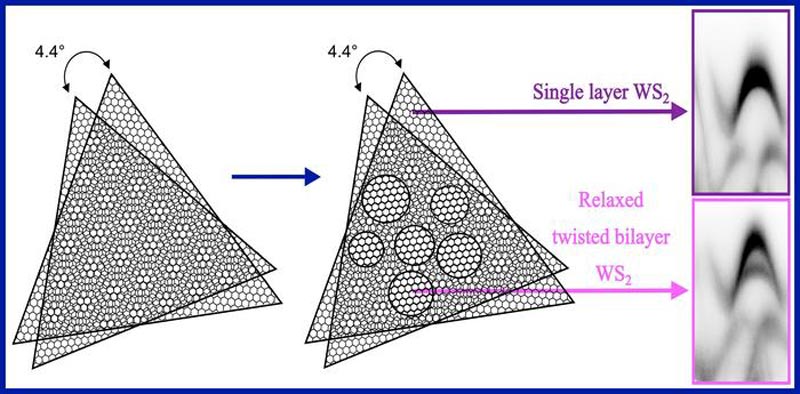

This illustration shows the formation of relaxed domains within the twisted bilayer WS2.
Credit: University of Groningen
In the search for new materials that can enable more efficient electronics, scientists are exploring so-called 2-D materials. These are sheets of just one atom thick, that may have all kinds of interesting electronic properties.
If two sheets are placed on top of each other at specific angles, this may lead to new properties such as superconductivity. University of Groningen materials scientist Antonija Grubišić-Čabo and her colleagues studied such a ‘twisted’ material and discovered that it defied theoretical predictions.

Credit: University of Groningen
Together with colleagues from Poland, Germany, France, and Italy, Grubišić-Čabo and her team studied sheets of a 2-D material called tungsten disulfide. According to theoretical predictions, when two sheets, (called a bilayer), are stacked at an angle of 4.4 degrees, the electrons within the material should show a collective behaviour. ‘And when they are so closely connected, their collective behaviour can create new, fascinating effects,’ says Giovanna Feraco, first author of the study.
However, she did not see this collective behaviour in experiments, which can be explained by the interactions between atoms in the bilayer. The twist normally enables these interactions. ‘But by studying the electronic structure in the bilayer, we discovered that this material tends to “relax” into large, untwisted regions,’ Feraco explains. In technical terms, the twisted bilayer partially reverts to a lower-energy, untwisted configuration.
This finding highlights the importance of understanding how the two sheets of the bilayer form different regions with varying properties. The study has also enhanced scientists’ ability to predict and manipulate the behaviour of 2-D structures, paving the way for future applications in different types of electronics.
Reference: Giovanna Feraco et al: Nano-ARPES investigation of structural relaxation in small angle twisted bilayer tungsten disulfide. Physical Review Materials, 26 December 2024
Journal: Physical Review Materials
DOI: 10.1103/PhysRevMaterials.8.124004
Method of Research: Experimental study
Subject of Research: Not applicable
Article Title: Nano-ARPES investigation of structural relaxation in small angle twisted bilayer tungsten disulfide
Article Publication Date: 26-Dec-2024
COI Statement: None
Media Contact
Rene Fransen
University of Groningen
r.fransen@rug.nl
Office: 50 3636951
Cell: 631921790














